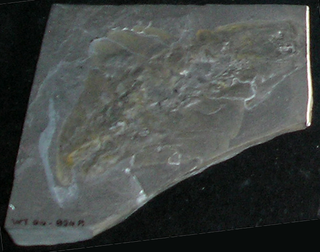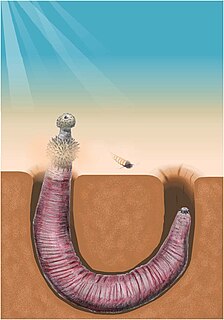
The Burgess Shale is a fossil-bearing deposit exposed in the Canadian Rockies of British Columbia, Canada. It is famous for the exceptional preservation of the soft parts of its fossils. At 508 million years old, it is one of the earliest fossil beds containing soft-part imprints.

Hallucigenia is a genus of Cambrian animal resembling worms, known from articulated fossils in Burgess Shale-type deposits in Canada and China, and from isolated spines around the world. The generic name reflects the type species' unusual appearance and eccentric history of study; when it was erected as a genus, H. sparsa was reconstructed as an enigmatic animal upside down and back to front. Hallucigenia was later recognized as a lobopodian, a grade of Paleozoic panarthropods from which the velvet worms, water bears, and arthropods arose.

Wiwaxia is a genus of soft-bodied animals that were covered in carbonaceous scales and spines that protected it from predators. Wiwaxia fossils – mainly isolated scales, but sometimes complete, articulated fossils – are known from early Cambrian and middle Cambrian fossil deposits across the globe. The living animal would have measured up to 5 cm (2 inch) when fully grown, although a range of juvenile specimens are known, the smallest being 2 millimetres (0.079 in) long.

Ottoia is a stem-group archaeopriapulid worm known from Cambrian fossils. Although priapulid-like worms from various Cambrian deposits are often referred to Ottoia on spurious grounds, the only clear Ottoia macrofossils come from the Burgess Shale of British Columbia, which was deposited 508 million years ago. Microfossils extend the record of Ottoia throughout the Western Canada Sedimentary Basin, from the mid- to late- Cambrian. A few fossil finds are also known from China.

Peytoia is a genus of hurdiid radiodont that lived in the Cambrian period, containing two species, Peytoia nathorsti and Peytoia infercambriensis. Its two frontal appendages had long bristle-like spines, it had no fan tail, and its short stalked eyes were behind its large head.

Canadia is a genus of extinct annelid worm present in Burgess Shale type Konservat-Lagerstätte. It is found in strata dating back to the Delamaran stage of the Middle Cambrian around 505 million years ago, during the time of the Cambrian explosion. It was about 3 centimeters in length. Charles Doolittle Walcott named Canadia in 1911 after Canada, the country from which its remains have been found. 28 specimens of Canadia are known from the Greater Phyllopod bed, where they comprise 0.05% of the community.
The fossils of the Burgess Shale, like the Burgess Shale itself, formed around 505 million years ago in the Mid Cambrian period. They were discovered in Canada in 1886, and Charles Doolittle Walcott collected over 65,000 specimens in a series of field trips up to the alpine site from 1909 to 1924. After a period of neglect from the 1930s to the early 1960s, new excavations and re-examinations of Walcott's collection continue to reveal new species, and statistical analysis suggests that additional discoveries will continue for the foreseeable future. Stephen Jay Gould's book Wonderful Life describes the history of discovery up to the early 1980s, although his analysis of the implications for evolution has been contested.

Ancalagon minor is an extinct priapulid worm known from the Cambrian Burgess Shale.

Archaeopriapulida is a group of priapulid-like worms known from Cambrian lagerstätte. The group is closely related to, and very similar to, the modern Priapulids. It is unclear whether it is mono- or polyphyletic. Despite a remarkable morphological similarity to their modern cousins, they fall outside of the priapulid crown group, which is not unambiguously represented in the fossil record until the Carboniferous. They are probably closely related or paraphyletic to the palaeoscolecids; the relationship between these basal worms is somewhat unresolved.

The palaeoscolecids are a group of extinct ecdysozoan worms resembling armoured priapulids. They are known from the Lower Cambrian to the late Silurian; they are mainly found as disarticulated sclerites, but are also preserved in many of the Cambrian lagerstätten. They take their name from the typifying genus Palaeoscolex. Other genera include Cricocosmia from the Lower Cambrian Chengjiang biota.

Eldonia is an extinct soft-bodied cambroernid animal of unknown affinity, best known from the Fossil Ridge outcrops of the Burgess Shale, particularly in the 'Great Eldonia layer' in the Walcott Quarry. In addition to the 550 collected by Walcott, 224 specimens of Eldonia are known from the Greater Phyllopod bed, where they comprise 0.43% of the community. Species also occur in the Chengjiang biota, and in Upper Ordovician strata of Morocco.
The Phyllopod bed, designated by USNM locality number 35k, is the most famous fossil-bearing member of the Burgess Shale fossil Lagerstätte. It was quarried by Charles Walcott from 1911–1917, and was the source of 95% of the fossils he collected during this time; tens of thousands of soft-bodied fossils representing over 150 genera have been recovered from the Phyllopod bed alone.
Cambrorhytium is an enigmatic fossil genus known from the Latham Shale (California), and the Chengjiang (China) and Burgess Shale lagerstätte. 350 specimens of Cambrorhytium are known from the Greater Phyllopod bed, where they comprise 0.7% of the community.
Mackenzia is an elongated bag-like animal known from the Middle Cambrian Burgess Shale. It attached directly to hard surfaces, such as brachiopod shells. 14 specimens of Mackenzia are known from the Greater Phyllopod bed, where they comprise <0.1% of the community. Mackenzia was originally described by Charles Walcott in 1911 as a holothurian echinoderm. Later, Mackenzia is thought to be a cnidarian and appears most similar to modern sea anemones.
Leptomitus is a genus of demosponge known from the Middle Cambrian Burgess Shale. Its name is derived from the Greek lept ("slender") and mitos ("thread"), referring to the overall shape of the sponge. 138 specimens of Leptomitus are known from the Greater Phyllopod bed, where they comprise 0.26% of the community.

Pagetia Walcott, 1916. is a small genus of trilobite, assigned to the Eodiscinid family Pagetiidae and which had global distribution during the Middle Cambrian. The genus contains 55 currently recognized species, each with limited spatial and temporal ranges.
Pirania is an extinct genus of sea sponge known from the Middle Cambrian Burgess Shale and the Ordovician Fezouata formation. It is named after Mount St. Piran, a mountain situated in the Bow River Valley in Banff National Park, Alberta. It was first described in 1920 by Charles Doolittle Walcott. 198 specimens of Pirania are known from the Greater Phyllopod bed, where they comprise 0.38% of the community.

Pollingeria is a problematic genus of animals of the Middle Cambrian Burgess Shale. 3080 specimens of Pollingeria are known from the Greater Phyllopod bed, where they comprise 5.85% of the community.
Lecythioscopa is a genus of probable archaeopriapulid known from two specimens from the Walcott Quarry from the Middle Cambrian Burgess Shale.

Peytoia nathorsti is a species of hurdiid radiodont from the Burgess Shale. It is the type species of the genus Peytoia.













